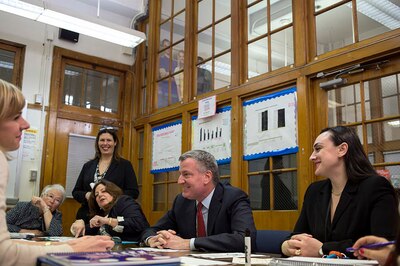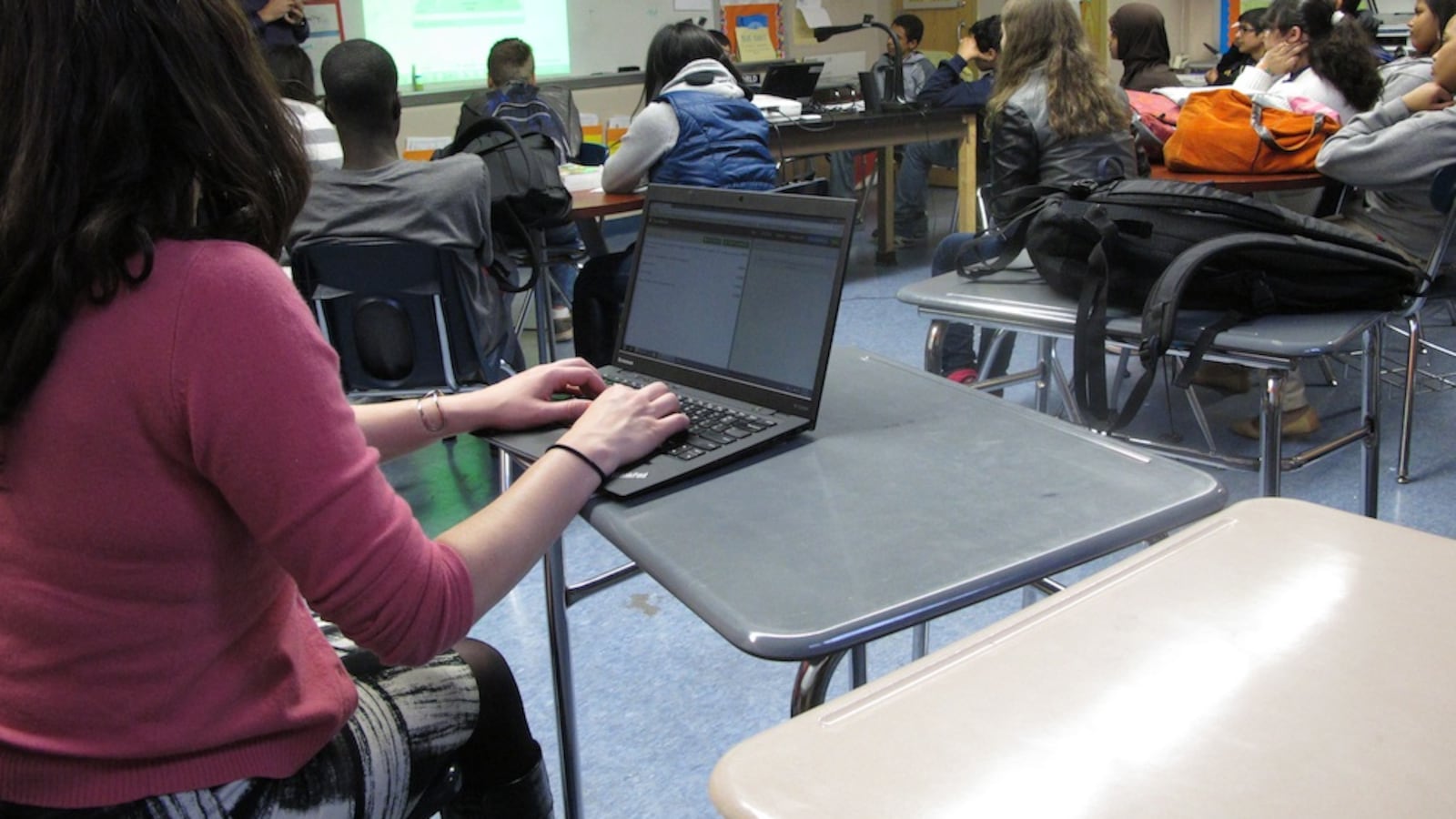Students who attend the low-performing schools at the heart of Mayor Bill de Blasio’s school turnaround initiative are twice as likely to have a low-rated teacher as their peers in an average city school, according to a Chalkbeat analysis.
More than 20 percent of teachers at the 94 struggling schools that are part of the city’s ambitious “School Renewal” program received the two lowest ratings on the state-mandated evaluation system last year, compared to less than 10 percent of teachers citywide who received those ratings – “developing” or “ineffective.”
While most teachers in Renewal schools — 77 percent — were still rated effective, students were also less likely to have a top-rated teacher: Less than 2 percent of 3,373 teachers in those schools received a “highly effective” in 2013-14, compared to 9.2 percent of the city’s teachers overall.
The analysis offers new fodder in the divisive debate over how to fix struggling schools, which has inspired lobbying campaigns this winter and even overlapped into a referendum on renewing mayoral control. De Blasio, meanwhile, has staked the success of his initiative in part on the idea that its schools can improve rapidly without significant staff changes — a departure from his predecessor Michael Bloomberg.

“Most teachers are here for the right reasons,” de Blasio said last month. “Most teachers can do a lot better if they’re given training, additional support and good leadership.”
Evaluating the Evaluations
To some, the results hint at a larger pattern of inequities in public education. To others, they are unreliable and, possibly, unfair to those who are teaching in the most challenging environments.
The Renewal schools have disproportionately high numbers of disadvantaged students and students of color, populations that are also far more likely to be taught by new and uncertified teachers. High-poverty schools in New York City also grapple with higher rates of teacher turnover than schools serving better-off students.
“It certainly is possible that the teachers in these Renewal schools are not as good, because it is the case that schools with challenging populations have difficulty holding onto experienced teachers who are good at their jobs,” said Aaron Pallas, a professor of education and sociology at Teachers College Columbia University.
Like several other education researchers who reviewed Chalkbeat’s analysis, Pallas cautioned against making conclusions solely from the evaluation data, which are based on a combination of student performance and classroom observations. Because of how the system was set up, he said, plans vary from one school to the next. (They are expected to become more standardized next year, following changes by the legislature last month.)
But the city’s results were closer to reality than other places that have implemented new evaluation systems in recent years, including the rest of New York State, according to Sandi Jacobs, vice president and managing director of state policy at the National Council on Teacher Quality. While almost every teacher elsewhere has received effective or better, Jacob said, there is at least some distribution in teacher quality in New York City.
“Here’s the question we really don’t know the answer to: Are the results really accurate reflections of teacher performance?” Jacobs said.
A spokeswoman for the Department of Education said last year’s ratings did not reflect the extra support that teachers were receiving this year. The city teachers union, which touted the results when they were released last year, did not respond to requests for comment.
State education officials — with prodding from the Obama administration — are planning to use the evaluation data to address equity issues around where high-quality teachers teach. By June, states need to develop and submit plans to the federal education department showing how districts and schools are ensuring the neediest students have equal access to high-quality teachers. The issue will be discussed at next week’s Board of Regents meeting, according to Chancellor Merryl Tisch.
The de Blasio way to teacher quality
City officials say they are committed to improving teacher quality in its struggling schools. But de Blasio’s strategy is less disruptive than Bloomberg’s, which reshuffled thousands of educators by shuttering schools and replacing them with new schools and new staffs.
Staffs in just two schools in the Renewal program are being forced to reapply for their jobs. At the other schools, officials have said they will encourage weak teachers to leave voluntarily, but officials say they’re also relying on extra support for existing teachers and bonuses to bring in new talent.
“We’re making a real concentrated effort on making sure that only the best teachers are in these schools,” Chancellor Carmen Fariña said.
That goal has long proven elusive, both in New York City and across the country.
Black and Hispanic students are far more likely than their white peers to attend schools with many new and uncertified teachers, according to data released last year by the federal education department’s Office of Civil Rights. In New York City, high-poverty schools grapple with higher rates of teacher turnover than schools serving better-off students.
“It is hard to attract the highest-performing teachers to come and work in my school,” Paul Asjes, a former lawyer now in his third year teaching at the School of Performing Arts, a Renewal school. “I feel like I work with strong teachers, but it’s hard to motivate new teachers to want to come and work here.”
A stacked deck in struggling schools?
In addition to looking at the final ratings, Chalkbeat’s analysis included two subcomponents that make up 80 percent of a teacher’s overall rating: classroom observations conducted by principals and assistant principals and students’ state test scores. The remaining 20 percent is based on a student learning metric decided by groups of teachers in individual schools.
The data shows that teachers in Renewal schools were as likely to receive below-average grades on both the observation and state testing measures.
The Renewal schools serve some of the more challenging student populations in the city, which teachers and principals said was an important factor in the evaluations. At the School of the Performing Arts, where Paul Asjes is a teacher, a quarter of students have lived in temporary housing in the last five years, and it has a larger share of overage students than the vast majority of middle schools in the city, according to city data.
An internal Department of Education analysis from midway through last school year looked at classroom observations, which make up 60 percent of a teacher’s final rating, and shows a strong correlation between lower ratings and serving larger shares of poor, black, and special-education students. There was also a strong correlation between higher ratings and the school’s more recent progress report card grade. Recent national research found observations were unfairly hard on teachers with students who entered their classrooms further behind academically.
Ratings vary widely
Although in general Renewal schools had lower-rated teachers, ratings varied widely among the schools.
At 24 of the 93 schools, teachers were rated higher than city averages, and at 36 schools, no more than one teacher earned an ineffective rating. (Data for one of the 94 Renewal schools in the turnaround program was unavailable.)
But in eight schools, more than half the teaching staff received low ratings. Those include: the Middle School for Academic and Social Excellence in Crown Heights, where 87 percent of teachers were rated developing; The Bronx Mathematics Preparatory School, with 86 percent rated developing or ineffective; and the Young Scholars Academy of the Bronx, where 66 percent of teachers earned a low rating.
At most Renewal schools, teachers were more likely to receive a lower rating on their observations. But in some schools that were exceptions, some staff acknowledged that passing their observations were relatively easy, in part because of concerns that low ratings could be demoralizing.
“In retrospect, we erred on the side of caution too much,” said one such principal, Andrew Turay, former principal of Peace and Diversity, where only two out of 14 teachers received less than effective ratings on their observations.
At Long Island City High School, two-thirds of teachers earned highly effective ratings on their principal observations, more than twice the city average.
“He wasn’t looking to fail us,” said one special education teacher at the school, explaining that her assistant principal was sympathetic on the observations component to offset the potential for low ratings on the student performance components.
Principal Vivian Selenikas did not respond to emails requesting a comment. A city spokeswoman said Long Island City administrators were getting additional coaching on how to more accurately use the city’s evaluation rubric.
“Having a strong teacher at the front of every classroom is critical at our Renewal Schools and at every school,” spokeswoman Devora Kaye said. “We are using an aggressive set of tools to improve these historically struggling schools and we’ll hold them accountable for improved student outcomes.”
Stay up to date with what’s happening in New York City schools and education policy with our daily newsletter. Sign up here

